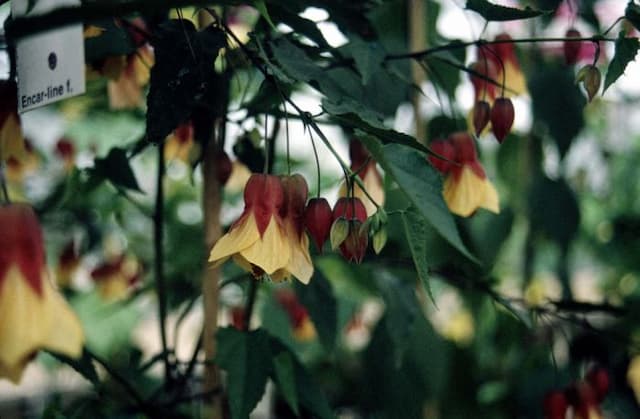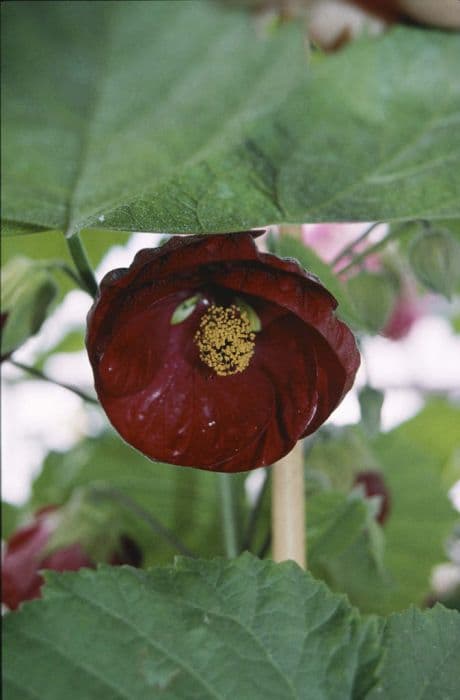Park Allegheny Mallow × Alcalthaea suffrutescens 'Parkallee' (d)

ABOUT
× Alcalthaea suffrutescens 'Parkallee', commonly known as the Parkallee hollyhock, is a striking perennial plant with a robust and bushy habit. It produces sturdy stems that bear a profusion of blooms. The flowers are large, with a lush color palette that ranges from soft creamy yellow to pastel pink shades, often with a darker pink or red center that adds an eye-catching contrast to the soft outer petals. These flowers exhibit a ruffled and somewhat cupped shape, creating a romantic and old-fashioned look. The foliage is also quite attractive, with rounded to heart-shaped leaves that have a slightly lobed appearance. The leaves are a deep green color, providing a luscious backdrop for the delicate flowers. Overall, the Parkallee hollyhock presents a harmonious blend of graceful blooms and verdant foliage, making it a beloved ornamental choice for gardeners looking to add a touch of cottage garden charm to their landscapes.
About this plant
 Names
NamesFamily
Malvaceae.
Synonyms
Parkallee Rose Mallow, Parkallee Hibiscus.
Common names
× Alcalthaea suffrutescens 'Parkallee'.
 Toxicity
ToxicityTo humans
The plant × Alcalthaea suffrutescens 'Parkallee', commonly known as Parkallee hollyhock, is not typically known for being poisonous to humans. There is no well-documented toxicity or symptoms of poisoning associated with this plant upon ingestion or contact for the general human population.
To pets
For pets, the plant × Alcalthaea suffrutescens 'Parkallee', commonly referred to as Parkallee hollyhock, is not widely recognized as a toxic plant. Therefore, there are no specific symptoms of poisoning reported for pets that ingest this plant. However, individual animals may have different sensitivities, and it is always prudent to monitor pets if they consume any plants and consult a veterinarian if any concerning symptoms arise.
 Characteristics
CharacteristicsLife cycle
Perennials
Foliage type
Deciduous
Color of leaves
Green
Flower color
Pink
Height
5-7 feet (1.5-2.1 meters)
Spread
2-3 feet (0.6-0.9 meters)
Plant type
Shrub
Hardiness zones
5
Native area
Cultivar
Benefits
 General Benefits
General Benefits- Attracts Pollinators: × Alcalthaea suffrutescens 'Parkallee', commonly known as the hollyhock mallow, is great for attracting bees, butterflies, and other beneficial insects to the garden.
- Ornamental Value: With its large, showy flowers and attractive foliage, this plant provides aesthetic appeal and is a beautiful addition to cottage gardens, borders, and flower beds.
- Drought Tolerance: Once established, the hollyhock mallow has good drought tolerance, making it suitable for xeriscaping and dry garden environments.
- Low Maintenance: It requires minimal care once established, making it a great option for gardeners seeking low-maintenance plants.
- Rapid Growth: The plant tends to grow quickly, providing a fast fill-in for newly planted gardens or empty spaces.
- Long Blooming Season: This hybrid generally has a longer blooming season than pure species of hollyhocks, offering colorful blooms from midsummer to fall.
- Cold Hardy: It can survive in cold climates, making it a versatile plant for various gardening zones.
- Architectural Height: The hollyhock mallow can reach significant heights, adding vertical interest and structure to garden designs.
- Wildlife Habitat: Apart from attracting pollinators, it can also provide shelter and food for wildlife, supporting local biodiversity.
 Medical Properties
Medical PropertiesThis plant is not used for medical purposes.
 Air-purifying Qualities
Air-purifying QualitiesThis plant is not specifically known for air purifying qualities.
 Other Uses
Other Uses- × Alcalthaea suffrutescens 'Parkallee', commonly known as hollyhock, can be used to create natural dyes for fabrics, with flowers and leaves providing different shades.
- As a biodegradable material, the fibrous stems of hollyhocks can be processed into paper or eco-friendly packaging alternatives.
- The sturdy stems of hollyhocks can be used in garden stakes or support for other plants, serving a functional role in garden management.
- Hollyhock flowers are edible and can be used as a colorful garnish in salads or as a decorative element on cakes and desserts.
- Dried hollyhock petals can be incorporated into potpourri mixes for their aesthetic appeal and subtle fragrance when dried.
- Floral artists may use the large, vibrant flowers of hollyhocks in flower arrangements or pressed flower art due to their size and texture.
- In textile arts, hollyhock petals can be used in silk flower making, offering a natural and delicate option for crafters.
- The tall structure and inflorescence of hollyhocks can serve as a natural trellis for climbing vines in mixed plantings.
- Hollyhock leaves can act as a mold for garden stepping stones or decorative concrete work, imprinting their pattern into the material.
- During the Renaissance, hollyhocks were sometimes used to decorate the stables of horses, believed to bring good luck and protection.
Interesting Facts
 Feng Shui
Feng ShuiThe Hibiscus 'Parkallee' is not used in Feng Shui practice.
 Zodiac Sign Compitability
Zodiac Sign CompitabilityThe Hibiscus 'Parkallee' is not used in astrology practice.
 Plant Symbolism
Plant Symbolism- Resilience: × Alcalthaea suffrutescens 'Parkallee', commonly known as the hollyhock, is a symbol of resilience as it can withstand challenging environments and still produce beautiful blossoms.
- Fertility: Hollyhocks are often associated with fertility due to their prolific seed production and vigorous growth.
- Heartfelt Emotions: The hollyhock's large, open blooms are reminiscent of an open heart, symbolizing the expression of deep feelings and emotions.
- Prosperity: With its ability to self-seed and thrive, the hollyhock is also seen as a sign of abundance and prosperity.
- Generosity: The bountiful blooms and generous seeding of the hollyhock represent a spirit of sharing and giving.
 Water
WaterThe Hibiscus syriacus hybrid 'Parkallee', commonly known as Parkallee Hibiscus, requires regular watering to maintain evenly moist soil, especially during dry spells. Water the plant with about 1 to 1.5 gallons per week, increasing to 2 gallons during peak summer heat. Ensure the water penetrates deeply into the soil to encourage a strong root system. Avoid overhead watering to reduce the risk of leaf diseases. Adjust the amount based on rainfall and check the soil moisture before watering to avoid overwatering.
 Light
LightParkallee Hibiscus thrives best in full sun to partial shade. Choose a spot that receives at least six hours of direct sunlight daily. However, in extremely hot climates, some afternoon shade can help protect the plant from scorching. Avoid heavily shaded areas which can lead to poor blooming and an increased risk of fungal diseases.
 Temperature
TemperatureParkallee Hibiscus is hardy and can tolerate a temperature range from about 20°F to 90°F, but it thrives best when temperatures are consistently between 60°F and 80°F. It can survive a slight dip below 20°F but may need protection during unexpected cold spells. During the growing season, ensure that the plant is not exposed to extreme heat without adequate moisture.
 Pruning
PruningPrune the Parkallee Hibiscus in late winter or early spring before new growth begins. This encourages a healthy shape, removes dead or damaged wood, and promotes vigorous growth and better flowering. Cut back about one-third of the old growth to stimulate new shoots. Pruning annually will help maintain the desired size and appearance.
 Cleaning
CleaningAs needed
 Soil
SoilHollyhock Alcea requires well-draining, fertile soil with a pH of 6.0 to 8.0. A mix of garden soil, compost, peat moss, and perlite in equal parts makes an ideal blend for optimal growth and bloom production.
 Repotting
RepottingHollyhocks, being mostly biennial, don't typically require repotting as they are sown directly into the ground where they will bloom for one or two seasons before reseeding or dying off.
 Humidity & Misting
Humidity & MistingHollyhocks are adaptable and do not require specific humidity levels; ambient outdoor humidity is suitable for their growth.
 Suitable locations
Suitable locationsIndoor
Grow Hollyhock Alcea with ample light and room, rotate for even growth.
Outdoor
Plant Hollyhock Alcea in sun, well-drained soil; mulch and water.
Hardiness zone
3-9 USDA
 Life cycle
Life cycle× Alcalthaea suffrutescens 'Parkallee', commonly known as Hibiscus 'Parkallee', begins its life cycle as a seed, which when sown, germinates to produce a small seedling. This seedling grows into a young plant with multiple leaves, and as it matures, it develops a woody stem, allowing it to become a perennial shrub. Throughout the spring and summer, Hibiscus 'Parkallee' produces its distinct large, creamy yellow flowers with a red center that are attractive to pollinators. After pollination, flowers develop into seed pods that, once mature, release seeds to enable the propagation of next generation plants. Approaching autumn, the plant begins to enter dormancy, with leaves yellowing and dropping as colder weather sets in. Lastly, it remains dormant during the winter, to revive and start the cycle anew with the return of warm spring temperatures.
 Propogation
PropogationPropogation time
Spring to Summer
Propogation: The most popular method for propagating × Alcalthaea suffrutescens 'Parkallee', commonly known as the Parkallee hollyhock, is by seed. Sowing can be done in late winter or early spring under cover, or directly outdoors once the risk of frost has passed. To ensure a good start, seeds should be sown in a well-draining seed starting mix at a depth of about 1/4 inch (approximately 6 mm). The soil should be kept consistently moist but not waterlogged. Germination usually occurs within two to three weeks, after which the seedlings need to be thinned or transplanted to give them adequate space to grow. Once the seedlings have developed a few sets of true leaves and are robust enough, they can be hardened off and transplanted to their final location in the garden.









